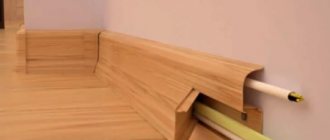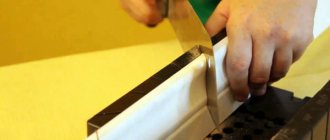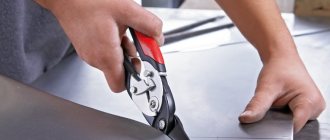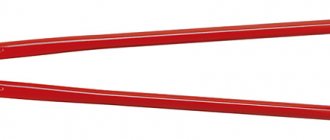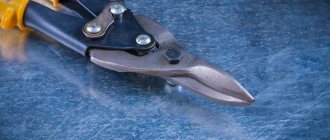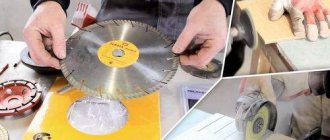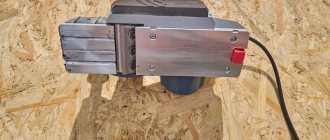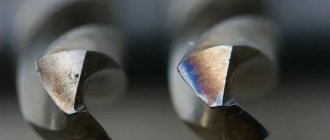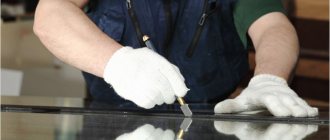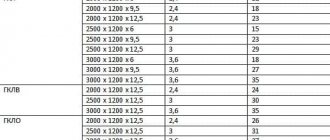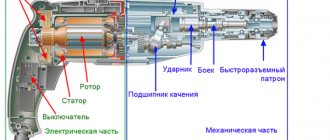As general information, it is worth saying that metal cutting is one of the types of metalworking. Other types of mechanical processing of metals include forging, bending, stamping, grinding, drilling, threading, etc., as well as chemical and thermal (thermal) methods. In other words, everything that allows us to obtain a product with the properties we need from a certain metal is metalworking.
The variety of methods for working with metals entails a variety of technical means. From files and chisels to CNC machines and industrial robots. You can get acquainted with the methods and machines themselves on the relevant websites; an example is the website of the Akron-System company, which is also interesting because it supplies not only equipment and components of different brands, but also offers the production of unique metal products according to our drawings.
In private house building and renovation, metal cutting is apparently the most popular type of work with metal products, along with drilling.
So, what do you need and can use if you need to cut a metal pipe, corner or rod, sheet or strip?
The tool and cutting method are selected depending on the thickness, type of metal, as well as the volume of work. The choice also depends on whether you have to cut metal without electricity or whether electricity is fine and, therefore, you can use a special tool.
Method 3 Use a vice and a hacksaw
This method is suitable for small volumes of work, with small cross-sectional sizes of a metal pipe, angle, iron strip, screw stud, etc.
Theoretically, you can manually saw off an iron pin five to seven centimeters in diameter or a fifty-fifty corner half a centimeter thick. True, this will take more than one hour of time and will require a lot of strength and endurance.
If you don’t have a hacksaw for metal, then sometimes a simple file will help, but rather not for cutting, but for cutting metal (for example, a thin rod for subsequent bending).
Method 4 We cut with an electric jigsaw and a metal file.
A jigsaw can be used for cutting, including shaped, thin (up to one or two millimeters thick) sheets of metal, as well as small cross-section corners, rods, pipes, etc.
The cutting speed is low, but quite high accuracy is achieved. When cutting more or less thick sheets of iron, it is recommended to lubricate the cutting surface with grease and a file.
Waterjet cutting of thick metal
This method of cutting thickened material can hardly be called innovative; it began to be used in production in the 1960s. The first in this matter was the American aircraft manufacturing company - it was its management that made an official statement, describing all the advantages of this technology and recommending it for cutting materials of increased hardness. After that, abrasive cutting with water began to spread more and more throughout the world.
The essence of this method is that water mixed with abrasive substances enters the cutting zone under high pressure. All modern waterjet cutting installations work like this: water and abrasive are supplied to the machine’s mixer (usually fine sand plays its role), the resulting composition enters the nozzle of the installation, where a thin stream of waterjet mixture is created, and under high pressure it is supplied to the material being cut, including thick , material.
Method 5 Cutting with metal scissors
This method is suitable for cutting thin sheets of metal (preferably soft).
There is a trick that allows you to use scissors to cut an iron sheet 2-3 millimeters thick (depending on the strength of the cutter). We fix the scissors in a vice with one handle, and put a piece of pipe on the other (it should be longer than the handle itself). We get a lever and, as a result, a fairly powerful machine for cutting metals. We feed the iron or steel sheet onto the scissors, press hard on the pipe and... cut the metal.
Another way to increase the strength of the scissors is, again, using a hammer. It is worth noting that all this will most likely lead to a deterioration in the accuracy and evenness of the cut.
By the way, modern metal scissors are quite diverse in appearance and design, among them there are also electric scissors (however, they no longer resemble scissors in their appearance and in general this, one might say, is another way of cutting metal, about which see below).
How to Cut Sheet of Metal with a Grinder
Rules for cutting metal with a grinder
Metal is the material for which an angle grinder (angle grinder) was originally designed. At the moment, it is used to cut reinforcing bars, various iron sheets, pipes of various diameters, brick, concrete, stone, tiles and other building materials. Thanks to the presence of a variety of attachments, the grinder also allows you to polish and grind the surfaces of products. Cutting metal with a grinder is one of the main, more common jobs. To reduce the likelihood of injury, it must be carried out correctly, in compliance with general and personal safety requirements.
Content
Preparing to use a grinder for metal
The grinder belongs to the level of relatively unsafe power tools. There is an option to get injured from a flying disc or a tool falling out of your hands. In any case, the danger is associated with the high rotation speed of the device’s electric motor.
To increase the efficiency of the grinder and expand its multifunctional abilities, the following additional devices are actually used:
Their use makes it possible to improve the quality of sawing iron blanks and increase the accuracy of the process. Working conditions also improve in terms of safety, and productivity increases.
The introduction of additional devices allows you to use the equipment as a machine created to perform various types of work.
To make the cutting process very safe, you should work on metal with an angle grinder in compliance with a number of rules. They are conventionally divided into preliminary and main (working) activities.
Before cutting, you need to perform a number of manipulations.
- Wear special work clothes and shoes (with anti-slip soles), gloves made of thick fabric or leather.
- Prepare, based on the characteristics and type of metal being cut, a suitable disk, and then install it with the markings facing the top, tightening it with a nut.
- Check the working attachments used for the presence of various flaws that violate their integrity: potholes, cracks and other deformations.
- Use personal protective equipment: goggles, a respirator or mask (shield), and sometimes also headphones.
- Check the functionality of the tool, the reliability of its casing (working without it is strictly prohibited), and the condition of the power cord and plug.
- Prepare the work area: remove flammable materials (lubricant, fuel, paper, rags) and all other disturbing things. Cover, in other words, move to a non-hazardous distance objects that could of course be damaged by hot metal particles.
If possible, the material to be sawn should be firmly fixed beforehand, for example, in a vice, in order to eliminate possible accidental movements. It is prohibited to hold the workpieces in the palm of your hand or between your knees.
Correct work with inventory
When you start sawing any part using an angle grinder, you should adhere to these rules.
- When cutting metal, you need to hold the grinder firmly, with both hands.
- There is an option to change the wheels only after they have completely stopped rotating and cooled down to the appropriate temperature, disconnecting the power tool from the power supply.
- Do not place the working tool on the ground or table (do not let it out of your hands).
- It is necessary to stop from time to time for about 5 minutes to rest and for the disk to cool.
- It is necessary to constantly take care of the condition of the cutting wheel, preventing it from being pinched by the edges of the workpiece being cut.
- Do not leave the tool plugged in unattended.
- Use only disks of the appropriate size, as indicated in the operating instructions for the device used.
- It is better to do the work on a flat surface so that the body position is stable.
- Make sure that the power cord is kept away from the rotating circle, sharp edges, and objects heated over 100 degrees.
- Movements not specifically related to cutting should only be done with the power tool turned off.
- It is necessary to be positioned on the side, as it is also called behind the tool, doing the work on your own so that parts of the body are not in the cutting plane.
When cutting metal with a grinder is finished, you should wait for the disk to stop working and disconnect the power cord of the tool from the mains. Afterwards it is recommended to make sure there are no signs of fire. When cutting materials, a right-handed person should correctly hold the handle of the device in the area of the on/off button with his right hand. In this case, the left hand is placed on a handle screwed into the body of the power tool from above.
READ Why the Interskol Grinder Doesn't Work
It is unacceptable to do work using an angle grinder in a very lethargic state, or while under the influence of alcohol, psychotropic or narcotic drugs.
As for the question of what, in which direction - only towards yourself or away from you - the disk of the turned-on angle grinder should spin, there is no specific answer. The operating instructions indicate that option 1 is correct. This is due to the fact that the resulting sparks fly away from the operator without causing harm. Also in this direction pieces of the circle will fly if it breaks into pieces.
Alas, if the passage occurs, when the rotating disk jams towards itself, the tool will fly off into the worker. Therefore, some specialists prefer to cut metal so that the circle rotates “from itself”. A power tool torn out of your hands will fly in the opposite direction. This reduces the possibility of injury, and the user will be protected from flying sparks by clothing, shoes and gloves.
Cutting sheet metal with a grinder
To cut metal of various types and thicknesses, use appropriate cutting wheels of various thicknesses and diameters. The method for cutting sheets is as follows.
- To cut using a grinder, sheet metal is first laid on a flat surface.
- Mark with chalk (marker) the clear dimensions of the cut out fragments along the sheet.
- Create sawing along the marked lines, without changing in this case the angle of the initial inclination of the disk to the working surface, so that it does not jam and break the power tool.
If you don’t have the ability to saw sheet metal with a grinder, it is recommended to practice on soft material beforehand - this will allow you to get a feel for how the tool works.
You need to think about what cuts metal better in the lower, near sector of the disk.
When cutting a sheet of metal, you should consider these tips to get a high-quality result.
- To improve cooling, you need to water the sawing area with water, which will also increase the life of the wheel.
- You should start cutting metal only when the disk is spinning: you cannot turn on the tool if the motionless circle is in contact with the surface of the workpiece.
- To saw tin (narrow sheet metal) or cut out various geometric shapes, it is more convenient to use small, machined circles (“bits”).
- There is no need to press the angle grinder with significant force: cutting should actually take place only under the weight of the angle grinder.
- If the cutting wheel stops in the slot (when you turn off the power tool), you can resume work only after removing it.
36 How to cut sheet metal completely evenly with a grinder Part 1
Tel. 8-916-172. three eight four nine. Call from 10 to 20 Moscow time. The video clip shows the most completely smooth.
How to correctly cut a sheet of metal 1x2m, 1.5 mm wide, in half, using a grinder.
Learning to cut sheets
, we have.
We will teach you how to cut
with
a grinder
. Subscribe to the channel.
If sawing the sheet occurs slowly, you should change the working attachment. Excessive load on the angle grinder when cutting metal will lead to overheating or jamming of the rotating wheel.
Cutting a round hole in metal using an angle grinder
In reality, you often need to cut a circle in metal, and the only tool available is an angle grinder. However, it is quite enough for this. The method of action for all this is as follows.
- Draw a circle with a compass on metal or on a previously made cardboard (cardboard) template with chalk or a marker.
- Holding the grinder at an angle to the surface of the sheet, they make a preparatory marking cut in the metal along the marked contour, making short movements with the disk (sawing in small sections).
- Then, moving the nozzle in the same way, deepen the slot until it is completely cut out.
It is necessary to cut along the outer contour of the circle so as not to reduce the size of the circle. If its diameter is small, then they cut by touching the metal with a disk point by point (without longitudinal movement of the nozzle). The round hole will have an oblique cut, additionally with some minor flaws (they depend on the skill of the worker). Afterwards it is processed, if necessary.
READ Grinder With Adjustable Speed
The process of cutting a round hole in sheet metal using a special device is shown in the video:
Features of working with thick metal, copper, cast iron, aluminum
When it is necessary to cut thick metal into separate pieces, it is recommended to additionally do the following:
- Our client can only create straight cuts;
- various curved contours should be cut out in separate straight sections of short length, while removing unnecessary parts;
- It is necessary to completely saw the workpiece over several approaches, deepening the slot with each step;
- if you need to cut corners, I-beams, channels, rails, then each of their structural parts is sawed separately.
Cutting cast iron, stainless steel, and non-ferrous metals, for example, aluminum and copper, is carried out using special wheels designed for working with these materials. All the necessary information about the discs is contained in the markings of these products, printed on their sides. With all this, the circles differ in the composition of the fillers:
- in some, the additive is a super-strong material that can cut alloy steel;
- others use mild binders.
Cutting stainless steel with ordinary metal cutting discs is prohibited, since they contain substances that lead to accelerated corrosion of the cut site . Aluminum and copper are very viscous non-ferrous metals. They are sawed using a grinder, pouring kerosene over the slot formed by the disc. At the same time, fire safety regulations must be observed.
Tips for cutting metal pipes
Cutting pipes from various metals is a necessary operation when carrying out repair and construction work. Products have to be cut off during the installation of sewer and heating systems and water lines. In solving this issue, the grinder is excellent at handling various tasks. Discs for performing work are selected according to the material from which the pipe is made.
Using an angle grinder allows you to:
- sawing pipes at different angles, for example 45 and 90 degrees;
- cut products of huge diameter;
- cut profile (rectangular or square) pipes smoothly;
- create longitudinal cutting of tubular blanks;
- sawing cast iron pipes;
- cut thin-walled tubes.
If it is necessary to cut a pipe of huge diameter, then the use of an angle grinder allows you to complete this work without significant expenditure of money. With all this, labor productivity is low, and the dangers are considerable. When long pipes lie on supports, only the hanging parts are sawed off. If you cut in the center, the cutting edges will jam the cutting wheel, which will lead to jamming of the tool and possible injury.
Specialists not only cut pipes from various materials at suitable angles, but also cut out holes of the required shapes. Work with profile and round workpieces is carried out in a similar way, with strict adherence to safety regulations.
Sawing pipes at different angles
It is necessary to cut round and profile pipes at an angle of 45 and 90 degrees when laying various communications. In any case, you need to saw off the pipe evenly so that the elements that need to be connected are tightly connected to each other.
A cut at an angle of 45 degrees for cylindrical pipes is carried out as follows:
- take an ordinary square cardboard sheet;
- fold it exactly at an angle;
- This template is used to wrap the pipe;
- chalk, or other marking device, is used to mark the future cutting line;
- remove the template;
- clamp the workpiece in a vice;
- cut off the marked piece of pipe.
When applying the template, it does not matter which of the two small sides of this triangle must become parallel to the central axis of the pipe.
When it is necessary to cut at an angle of 90 degrees, the pipes are simply wrapped in a circle (cylindrical) or around the perimeter (profile) with a sheet of paper. Then mark the cutting line. There is also an option to mark the profile pipe without much expense using an ordinary square.
If you want to cut a significant number of profile pipes at an angle of 45 and 90 degrees, make the appropriate templates from this material, only with a larger cross-section. This allows you to take the required measurements only once. Here, for initial marking, a construction square or protractor is used. When the template is made, the cut pieces are inserted inside it, marking the cut strips. Then they create the sawing.
READ Grinder Boch 150 With Speed Adjustment
Templates are made for other angles. This method increases labor efficiency.
Features of cutting metal and thin-walled pipes
Cast iron is a brittle material. To cut a cast iron pipe with a grinder, proceed in the following sequence:
- mark the cutting line
; - place a wooden block under the pipe, which will serve as a support for it;
- make a cut along the contour several mm deep;
- insert a chisel into the made recess;
- According to the instructions, they hit you very sharply with a hammer.
After the impact, the pipe will split along the cut strip. Its edges will be quite smooth. If necessary, they are further processed.
To perform longitudinal sawing of a pipe, clear markings are also important. To apply it, various devices are used, for example, construction thread (“beat”). The sawing method should be done carefully, slowly, so as not to stray from the marked strip.
Thin-walled pipes are one of the varieties of this type of product. They are often made from non-ferrous metals: copper or aluminum. Cutting them is a difficult task. In this case, you should use grinder wheels appropriate for the material of the workpiece.
Sawing thin-walled tubes must be done very carefully, since they can easily become deformed even when applying a slight load.
To reduce the possibility of bending of the cut part, various bulk fillers are poured inside it, for example, ordinary purified sand.
Cutting corrugated sheets and metal tiles
Sometimes you have to face the need to cut a profile sheet to fit another iron tile. These materials are made of steel, which is coated with zinc and polymer layers of protection and painted.
There are different ideas regarding the ability to use an angle grinder for cutting them. The installation instructions state that corrugated sheeting cannot be sawed using an angle grinder. For this purpose you need to use other tools. But they need to be obtained, which is rarely justified by the volume of future work, and also requires additional financial investments. When you don’t have any tools other than an angle grinder while cutting with a grinder, you need to know the likely bad consequences.
- If you cut metal tiles or corrugated sheets with an angle grinder, the protective coating in the cut area and a little around it will be destroyed, and the docked edge will begin to rust.
- The material is removed from warranty.
- Flying sparks can spoil not only the appearance of the rest of the sheet (scorch the paint), but also additionally destroy the polymer coating.
- The edge of the cut may turn out torn.
What remains for our client to do? Considering the bad consequences, there is a minimal option, if you cut corrugated sheets or metal tiles with a grinder, following the following tips:
- do all the work before installation;
- treat cuts with anti-corrosion compounds;
- cover the cut edges with a primer and paint;
- use discs for metal of small thickness (up to 1 mm);
- In order for the edges to remain careful, it is necessary to cut quickly enough;
- Gently sand the torn edges.
Before sawing, as usual, the sheets are marked.
If you need to cut a square, do this:
- draw it out on the sheet;
- cut through the material along the marked contour with a grinder;
- Finally, carefully cut out a corner.
Circles, in other words, other figures are cut out, working according to the same pattern.
Using a grinder for cutting iron tiles and corrugated sheets simplifies the work. It becomes more convenient to do this, since you can adjust the size of the sheets specifically on the roof.
In order for metal tiles or corrugated sheets to remain under warranty, you should measure the object and order factory cutting of the sheets. You can also try to select a material with dimensions such that trimming is not required.
Cutting metal with a grinder
- This is a cheap, actually accessible and quite effective method of sawing it. Here, proper discs without flaws should be used for each material. For this reason, not only the quality of the result obtained, but also your own health directly depends. When sawing metal, it is imperative to follow safety rules and use personal protective equipment. You should always keep in mind that when working with an angle grinder, any shortcomings or inattention can lead to injury. Therefore, it is necessary to work concentratedly and carefully.
Source
Method 6. Cutting metal with a grinder
An angle grinder is an angle grinder on which various grinding, abrasive, and cutting wheels are installed. A special cutting disc is used for cutting metals. After cutting, the cut area is treated with a grinding disc.
A grinder today is perhaps the most productive tool for non-professional metal cutting. It makes it quite easy to cut both pipes, rods, corners, and (with some training) sheets of metal. See also more details about the types of working discs for grinders.
How to properly cut metal with a grinder. Practical tips and advice
If long pipes lie on supports, you need to cut off their overhanging edge. If you cut them in the middle, then due to its own weight the metal will bend and jam the disk.
If you do not have the skills to handle an angle grinder, then before starting work you should learn how to cut unnecessary parts.
The cutting wheel only takes radial forces. Attempting to change the cutting plane while the blade is inside the metal part will result in its failure.
The heel of the disc (the near lower part of the circle) cuts metal more efficiently.
In order for the grinder and discs to serve for a long time, every 5-7 minutes of work you need to take a break of 20-30 minutes
This rule is especially important for low-power grinders who are afraid of overheating. To increase the service life of discs, especially expensive ones, and to cool the metal, the cut area should be watered
It is advisable to carry out the work together.
To increase the service life of discs, especially expensive ones, and to cool the metal, the cut area should be watered with water. It is advisable to carry out the work together.
Aluminum is a very tough metal. When cutting a piece of large thickness, you need to drip kerosene into the seam, observing fire safety rules.
For molding, cutting tin, and figured carvings, you should use worn-out disks—“bits,” so you shouldn’t throw them away right away.
It is correct to cut the corner not in one step, but separately both shelves.
If pipes, angles, or fittings are long enough to rest on supports, cut the overhanging edge correctly. If you cut between the supports, the part will bend due to its own weight and jam the disk.
Parts of large thickness are cut only in a straight line. If you need to cut out a shaped part, first straight cuts are made, then the remaining unnecessary parts are removed.
You should not put pressure on the grinder. This will lead to jamming or breakage of the disc and overheating of the angle grinder. If the cutting process is slow, the blade should be replaced.
The resulting cut should not be processed with the side of the disk. A different type of disk is used for this.
Molten particles of metal and abrasive, falling on plastic products, glass and car headlights, stick to them, and then it is almost impossible to remove them. Therefore, they must be removed or protected before work begins.
Method 7 Cutting with a reciprocating saw
A reciprocating saw or electric hacksaw is a relatively new tool on our market. Like a jigsaw, this saw can change its blades, therefore, along with cutting wood, it is used for cutting soft and hard metals (stainless steel, aluminum), as well as aerated concrete, plastic, craton, etc. This tool is more powerful than a jigsaw. In addition, the saw is more mobile and does not require support during operation. Can be used for quickly cutting iron pipes with a diameter of 2-3 centimeters or more (see video below).
What and how to make a hole in a sheet of metal?
It all depends on the size of the hole. If the diameter is small, a drill will do. If large holes are needed, special drill bits are used. Pay attention to the material from which the horse-drawn horse is made. To process profiled sheets, you should use nozzles with a carbide coating. Processing should be carried out without increasing the temperature.
A jigsaw is used to make a large diameter hole. With this tool, cutting out a circle of large diameter will not be difficult. When working, use a saw with fine teeth
Source: the-master.ru
Method 8 Use a pipe cutter
At home, you can use handheld pipe cutters (for example, RidGid pipe cutters) to cut pipes. Using special cutter rollers or scissors, a pipe cutter allows you to cut pipes up to 10 centimeters or more in diameter. Moreover, with high quality and evenness of the cut, which is especially good for soft metals (for example, copper pipes). The disadvantage is its narrow purpose - it is used only for cutting pipes.
Oxygen cutting
Oxygen cutting in many cases is mechanized using special
portable devices and gas cutting machines. When using oxy-fuel cutting, not only acetylene is used, but also other flammable gases, such as natural and petroleum gases, hydrogen, as well as liquid fuels - kerosene and gasoline.
Oxy-fuel cutting is superior in quality and productivity to many other cutting methods, which is why it is widely used.
Also important is the method of cutting with an oxygen lance, which is used when sawing through metal in metallurgical furnaces, creating holes in concrete, etc. Cutting with an oxygen lance is performed using a low-carbon steel tube into which oxygen is supplied to the cutting site. First, the cutting site and the end of the tube are heated with the flame of a gas welding soldering iron, and then oxygen is supplied to the tube. When the end of the tube lights up, it is pressed to the cutting site and the cutting process is carried out due to the combustion of the metal of the tube and the product in a stream of oxygen.
Method 9. We cut metal with a multifunctional power tool (Renovator multitool, multicutter).
A new, widely advertised tool that comes with different attachments, including those used for cutting metal.
One of the promoted tool names is the Renovator multitool. True, other manufacturers (including Bosch, Dewalt, Makita, etc.) do not use this name. Due to its versatility, you should not expect serious capabilities for cutting large-sized metals from a renovator. Best used for trimming protruding nails, screws and other small metal cutting, especially in hard-to-reach places.
Method 10. Cutting with electric metal scissors
Electric shears are an excellent tool for cutting sheet metal, used by both professionals and amateurs. Relatively inexpensive models, for example, the Interskol brand, will help cut sheets up to 2 millimeters thick. More powerful professional versions can handle metal up to 3 mm thick or more.
Metal shears will be extremely useful for those who cut metal tiles, corrugated sheets, etc. After all, alternative cutting with a grinder, even using a special metal circle, spoils the protective layer of the metal tile. And scissors allow you to make a neat cut without affecting the protection of the metal.
Are hand-held metal shears used for cutting corrugated sheets?
They are used, but the tool requires work experience and certain skills - in their absence, you risk getting deformed edges or “burrs” on the edges of the corrugated sheet.
In what cases is it used?
If you need to get a straight cut on one profiled sheet up to 0.6 mm thick. This tool is not used for cutting several sheets at the same time.
Attention: when choosing perforated scissors, pay attention to the length of the handles - the longer they are, the less effort you will put into the process.
We looked at the main tools that are useful for cutting corrugated sheets with your own hands. Choose the ones that are optimal in your case:
- If you need to cut a sheet lengthwise or crosswise, it is better to choose power tools - a jigsaw, slotted or nibblers, or a drill attachment. Their productivity is higher than that of manual ones. The work goes quickly, while you apply a minimum of physical effort. Also, many power tools are distinguished by their maneuverability; with their help, you can obtain straight and curved cutting lines. They are characterized by high cutting quality: there are no “burrs” on the metal and no edge deformations.
- If you need to cut a small hole of a simple shape or carefully cut off a small part of the metal, you can use hand tools - a hacksaw or cutting shears (they are also used as auxiliary, and not the main tools for cutting).
They have their advantages. Hand tools:
- More secure. The risk of injury during operation is minimal.
- They are low cost, so they are available to almost everyone.
- Minimal impact on the polymer coating and zinc layer.
- If you need an effective and inexpensive power tool, consider an electric jigsaw or a cricket attachment for a drill.
- If a clean cut line, maneuverability and fast work speed are paramount, electric shears for cutting corrugated sheets (nibblers or slotted) are optimal.
- If you choose manual cutting shears, we recommend that you first practice cutting corrugated sheets. This tool requires experience, otherwise the result of the work will be unsatisfactory - deformed edges of the corrugated board, “burrs”.
- If you have no experience working with hand tools, choose a hacksaw - it cuts slowly, but is easier to work with.
The categories mentioned in the article are:
Profiled sheet
Method 11. Professional methods of metal cutting
These include plasma cutting, gas cutting, laser, water, using band saws, etc.
We can also use all these methods - if we contact a company or a professional who provides metal cutting services. Method 7 is good if large volumes of work are required, hard or, on the contrary, very soft metals, as well as large sizes of cut surfaces.
Universal injection cutters
One of the modern methods of cutting thick sheets of metal is the use of injection cutting. The injection cutter consists of a barrel and a tip. The injection device of the cutter is the same as the burner device.
Mouthpieces should be particularly important parts of cutters. Today, all mouthpieces are made from BrKh0.5 bronze.
Mouthpieces are available with an annular flame (Fig. a) and multi-nozzle (Fig. b).
a - slotted; b - multi-nozzle: 1 - heating flame, 2 - cutting pure oxygen
Requirements for cutters
According to GOST 5191-79E, cutters that are designed for separation cutting with oxygen (the thickness of the metal being cut) are divided into the following capacities:
- small;
- average;
- big.
For cutters:
- low power can cut metal 5 mm or more up to 100 mm;
- medium power can cut metal 8 mm or more up to 200 mm;
- high power can cut metal 10 mm or more up to 300 mm.
Cutting metal from 3 mm to 100 mm thick is also possible using insert cutters. It should be remembered that there are no high-power insert cutters.
Each cutter comes with size 0 mouthpieces; 1; 2; 3; 4; 5; 6.
Depending on the type and model of the cutter, replaceable mouthpieces are divided into:
- into components (external and internal);
- monoblock (non-separable).
The length of the cutters according to GOST should be no more than 700 mm.
